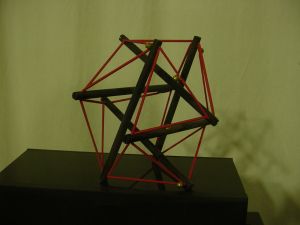The Guy Responsible For That Thing Sitting On My TV
 Slate has a neat piece on Kenneth Snelson, a mathematically orientated artist. Apparently, he and Buckminster Fuller invented tensegrity, where structural elements both push and pull on each other (the origins are murky, though Snelson seems to have more responsiblity, with Fuller coining the term). Snelson has a FAQ on the whole concept behind his art. It’s the triangulation of forces found in high school physics books manifest as steel and cable.
Slate has a neat piece on Kenneth Snelson, a mathematically orientated artist. Apparently, he and Buckminster Fuller invented tensegrity, where structural elements both push and pull on each other (the origins are murky, though Snelson seems to have more responsiblity, with Fuller coining the term). Snelson has a FAQ on the whole concept behind his art. It’s the triangulation of forces found in high school physics books manifest as steel and cable.
The Slate piece notes that he recently had a show in a New York gallery, but there was very little notice of it. (Sadly I missed it; Slate is where I’ve first heard of the artist, so I wouldn’t have known about a show at all. Admittedly I’ve let my New Yorker subscription lapse. If anything, that magazine might have had a blurb I would have seen when I browse through the events listings.) The main reason he’s ignored by most art critics is because he’s one of those rare mathematical artists, so he doesn’t fall into any well-defined school or movement. And, anyway, “art critics were the kids who failed high-school math.”
Like buckyballs, tensegrity has wider applications than just art. The piece finishes with a note about a biologist at Harvard who, after seeing Snelson’s work, realized that animal cells must follow similar principles; they’re not just little sacks of fluid. This work has implications in how tissues form, how cell structure fails, how humans might have to deal with space.
In another life, I bought a mathematical toy based on tensegrity. After I got it into its current shape, I never tried building other ones from the pamphlet. If only I had a larger kit, I could build something wacky that look like Snelson’s Rainbow Arch.